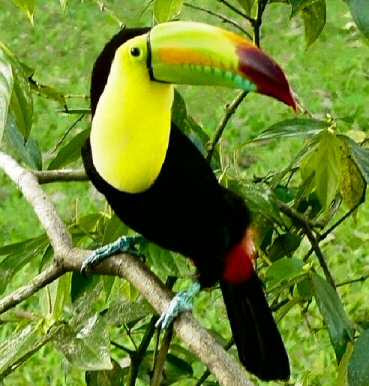Wagner (1944) published noteson the breeding of the Emerald Toucanet (Aulacorhynchusp rasinus)
in southern Mexico. Apparently the earliest account of all stages in the nesting of a toucan,from laying to the departure of the nestlingsw, as my life history of the Blue-throated Toucanet (A. caeruleogularis S kutch, 1944). Important details of the nesting of this small highland toucan were
addedi n a later account( Skutch, 1967). Observations on the breeding and general behavior of two species of middle-size aracari toucansw ere recorded in another paper (Skutch, 1958).
 |
| Keel-Billed Toucan |
The present contribution to the natural history of toucans is based largely upon studies made at Finca "La Selva" in 1967 and 1968. This property,l argely covered by primeval rain forest but with extensive riversidep lantations of cacao,l ies alongt he left bank of the Rio Puerto Viejo just above its confluence with the Rio Sarapiqui,a tributary of the Rio San Juan in the Caribbean lowlands of northern Costa Rica. Slud (1960) has well describedth e lofty, epiphyte-burdenefdo rest with an undergrowth consisting largely of small palms, and given an account of its avifaunaremarkably rich in species.
Including their enormous bills, adult Keel-billed Toucans (which in other writings I have called Rainbow-billed Toucans) range from about 17 to 22 inches in length. Even without the many-hued bill, this toucan with contrasting areas of white, yellow, red, and black would be a spectacular
bird; attached to a boldly patterned body, the delicately tinted bill makes it one of the most colorful inhabitants of the Central American forests. In the southern race (R. s. brevicarinatus), the greater part of the swollen upper mandible is yellowish green; there is an elongated patch of bright
orange along the basal half of its cutting edge; and the terminal fifth (approximately) is dull red. The lower mandible is green at the base, then light blue, then dull red on approximately the terminal eighth.
 |
| Keel-Billed Toucan |
Both man dibles are marked with a few short, w idely spacedd, ark, verticalb ars. A narrow black border outlines the whole bill at the base. The bare skin surrounding the dark eye is pale green. The legs and toes are blue-gray. Males average larger than females,e specially in the size of the bill, but
their measurementosverlap. While in some pairs the difference in size is great enough to permit their recognition in the field, in the pair whose nesting we followed ( and to which the above description of the colors of the featherless parts applies) we detected no difference betweent he sexes.
The Keel-billed Toucan ranges from southern Mexico to northern Colombia and extreme northwestern Venezuela. An inhabitant of humid forests, in Central America it occurs chiefly on the wetter Caribbean side. In northern Costa Rica, where the continental divide is low, it is found
in the forests of the Pacific side, where the dry season is severe,e specially if these forests are keptverdant by a high water table. But in the southern part of the Pacific slope of Costa Rica, separated from the Caribbean littoral by the high Talamancan range, this toucan was absent from the heavy evergreen forests that until recently covered most of the Valley and the Golfo Dulce region.
 |
| Keel-Billed Toucan |
That competition from its slightly larger congener was not the causeo f the Keel-bill's absence irom this region is attested by the fact that on the Caribbean side of Costa Rica and Panama the two species live in harmony, sometimes nesting close together. A ltitudinally the Keel-billed Toucan ranges from sea level up to about 4,000 feet in Costa Rica and to 5,000 feet in the Santa Marta region of Colombia.
Keel-billed Toucans venture into neighboring areas with scattered tall trees--shaded plantations of
cacao or coffee, pastures, second-growth woods--to forage and sometimes even to nest. On these excursions one has opportunities to study their social organization and manner of flight such a she seldom enjoys in the midst of the forest. They travel in small parties of up to a dozen individuals,
rarely more, that exhibit none of the closely coordinated maneuvers of a flock of parrots or pigeons. When one takes wing, its companions linger behind,a s though debating with themselves whether to follow.
At the time of analyses, the Keel-Billed Toucan SSP population is 62 (33.28.1) distributed among 24 AZA institutions. The Piciformes Taxon Advisory Group’s 2003 Regional Collection Plan recommended keel-billed toucans be managed with a target size of 75 individuals under the Toucan SSP. Genetic and demographic analyses of the population were performed in March 2008 at the AZA Regional Conference in Birmingham, Alabama, resulting in the current SSP Breeding and Transfer Plan. Analyses were based on the American Regional Keel-billed Toucan Studbook (current to 30 November 2008) using PopLink 1.30, SPARKS 1.52 and PM2000 1.212. This is the first breeding and transfer plan for this species. The goal of these recommendations is to help insure the genetic and demographic health of this population.
Nineteen Keel-Billed Toucan birds were excluded from the genetic analyses unknown pedigree or health issues. Exclusions are listed in Appendix A. No assumptions were made in connection with unknown pedigree birds. One bird (male 269) died during the comment period.














